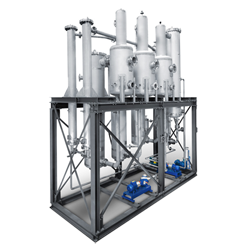World market is going through a bad phase and all industries are getting affected. Competition is strong and it has affected margins in general. In such grim situation one has to really start thinking afresh on various profit making avenues which were being ignored in better times.
The ideal way of looking at it is basically looking at points to save wastages of various resources and recover it profitably wherever possible.

EXPLANATION :
Mercerisers for Textile Mills generate dilute caustic liquor, which if drained to effluent treatment plant, will create considerable problems in meeting the environmental standards. caustic recovery system / caustic soda recovery plant by concentrating wash liquor and using the same back in Merceriser is the only feasible solution.
PRINCIPLE :
OPERATION :
Weak Caustic lye, around 5-6 Be ( 40 – 50 gpl ), is collected from the impregnation and washing chamber into a storage tank. It is then taken to a filtration unit to filter the suspended solids, fluff etc The feed to CRP then passes through a series of preheaters which preheat the wash liquor with the help of flash vapors from the condensate flashes ensuring minimum steam loss in heating the Wash liquor to its boiling point. The liquor in the tubes comes in contact with the steam in the shell side of heater 1 and the liquor starts boiling. The vapor liquor mixture enters the flash vessel through a tangential entry and the vapors get separated and enter the shell of the 2nd stage. The boiling in the successive effect takes place due to lower pressure created with help of a water ring vacuum pump. Due to lower pressure the boiling point of the liquor is reduced and it starts boiling. The concentrated liquor enters the 2nd heater due to the pressure difference and comes in indirect contact with the generated vapors and the same procedure is repeated. The concentrated product is removed from the last stage by a product pump. This later is taken either to a storage tank or to a Concentrated Lye purification system.
Under caustic recovery system / caustic soda recovery plant vapors generated at the last stage need to be condensed. This is done by either HOT WATER or an ADIABATIC EVAPORATOR system. In case of a hot water system, water at room temperature is passed through tubes of an exchanger and it gets hot due to the vapors. This hot water is uncontaminated and hence can safely be used in the process or the boiler as per the requirement.
In some cases where the hot water generated cannot be effectively consumed the effluent is passed through the exchanger and sprayed in an Adiabatic Evaporator Here the waste heat is lost in form of vapors and hence effective steam consumption of steam is reduced. Also nuisance of excess hot water is eliminated.
APPLICATION :
Under caustic recovery system / caustic soda recovery plant , Caustic concentration has applications in every industry where dilute caustic is produced due to washing and the concentrated liquor can be reused Various applications where caustic is reused are :
Knit Mercerising :
Knit mercerising usually has very few impurities such as size, starch and hence the recycled caustic is also pure. The recycled caustic can be reused for a longer period of time before the cumulative impurities reach unacceptable levels.
Woven Mercerising :
Grey knit mercerising has lot of size in the weak liquor and hence the recycled caustic has to be replaced frequently say once in a week Desized mercerising contains relatively lesser impurities and hence can be recycled longer say around 1 – 2 months Bleached mercerising hardly contains any impurities and hence caustic can be recycled for 5 – 6 months without having to replace it.
Denim Mercerising :
Weight Reduction machine for Polyester :
During weight reduction of polyester the weak liquor of caustic generated can be recycled after separation of suspended impurities and oligomers.Black liquor concentration in case of paper industry where the caustic weak lye from the digester is concentrated. The concentrate can then be taken to either a reboiler or gasifier or a Fluidised bed dryer for further treatment. Pet jar recycling units where the old pet jar bottles are cleaned with soap and then washed with caustic. The jars after cleaning produce weak liquor which after recycling can be reused.
Energy costs :
Anu Enviro Engineers steam consumption is 25% to 30% lower than any other Manufacturer. Considering the fact that the running cost of CRP is almost 3 -4 times the plant cost itself, Anu Enviro Engineers customer saves money equal to the plant cost every year.
Condensate Quality :
Demister pad arrangement ensures good quality of condensate not over 9pH ensuring minimum loss of caustic through condensate.
Control Systems :
Entire plant operations can be automated and hence the plant can be monitored by a single person.Advanced Plants are equipped with Level, density, pH controllers along with safety modules and PLC controlled operations with SCADA.
Scope of Supply :
ANU ENVIRO ENGINEERS LLP offers the plant on truly turnkey basis with no hidden scopes.Purification systems, pumps, filters are all included in the offer whereas most competitors ask client to buy it as optional accessories or get it manufactured onsite as per their specifications at clients cost.
Life of Caustic recovery Plant :
ANU ENVIRO ENGINEERS LLP considers a higher corrosion allowance and hence designs higher tube thickness ( 1.6 mm ) whereas most competitors consider tube thickness of 1.2 mm.This obviously has higher chances of damages and replacement.
